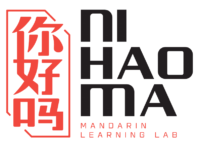In Chinese grammar, Chinese complements are essential components that add meaning to verbs or adjectives, helping sentences become more complete and accurate. However, Chinese complements are incredibly diverse, with each type serving its own distinct function. In this article, let’s join Ni Hao Ma to explore the most important types of complements in Chinese grammar.
What Are Chinese Complements?
Chinese complements (补语 – bǔyǔ) are grammatical elements that appear directly after a verb or adjective in a sentence. Their purpose is to provide additional details about the result, degree, direction, duration, or state of an action or event.
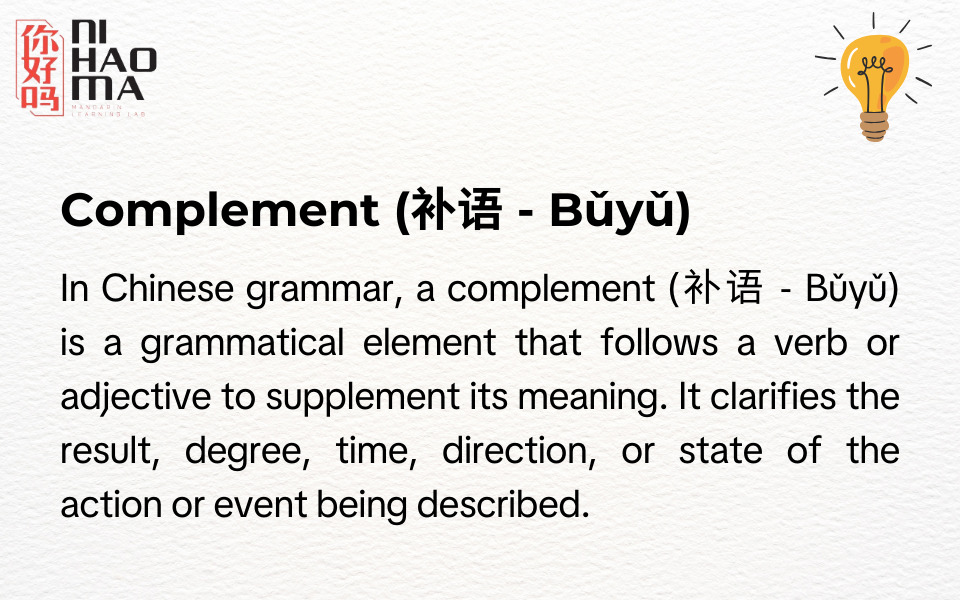
In simpler terms, verbs and adjectives in Chinese often do not fully convey the intended meaning on their own. This is where complements come into play — they expand, clarify, or emphasize the meaning of the verb or adjective. Because of this, complements form a crucial part of Chinese grammar, especially when it comes to expressing precise and detailed ideas.
Example:
- 我看完了这本书。 (Wǒ kàn wánle zhè běn shū.)
→ The complement “完” (wán) indicates the result: the action of reading has been completed. - 他跑得很快。 (Tā pǎo de hěn kuài.)
→ The complement “得很快” (de hěn kuài) describes the degree: the action of running is done very quickly.
Types of Chinese Complements
Complements help verbs and adjectives convey fuller meanings, ensuring sentences are semantically complete. Without the right complement, a sentence might sound vague or incomplete. In Chinese, complements are categorized into six main types, each with its own unique function and grammatical usage.
1. Result Complement
The result complement is a type of Chinese complement that attaches directly after the verb to indicate the result or outcome of the action. With result complements, the listener or reader understands whether the action was successfully completed, what effect it caused, or whether the desired outcome was achieved.
| Sentence Type | Structure | Example |
|---|---|---|
| Affirmative | Subject + Verb + Result Complement + (Object) | 我写完作业了。 (Wǒ xiě wán zuòyè le.) I have finished my homework. |
| Negative | Subject + 没 (méi) + Verb + Result Complement + (Object) | 我没写完作业。 (Wǒ méi xiě wán zuòyè.) I haven’t finished my homework. |
| Question | Subject + Verb + Result Complement + (Object) + 了吗? | 你写完作业了吗? (Nǐ xiě wán zuòyè le ma?) Have you finished your homework? |
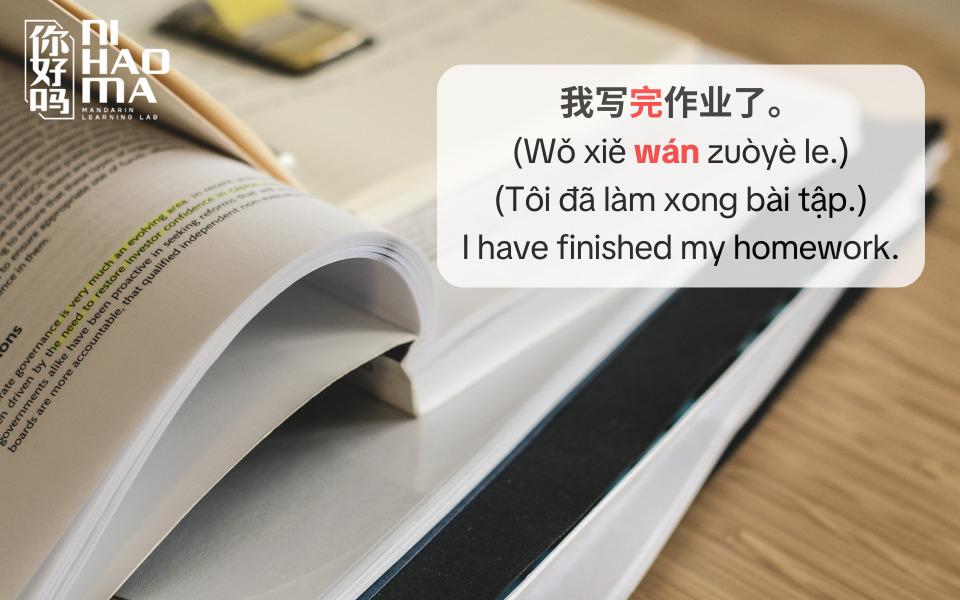
2. Complement of Ability
Complement of Ability (可能补语 – kěnéng bǔyǔ) is a type of Chinese complements used to describe whether an action can or cannot be performed. This complement expresses the possibility of successfully carrying out an action by inserting “得” (de) or “不” (bù) between the verb and the result complement or directional complement.
| Sentence Type | Structure | Example |
|---|---|---|
| Affirmative | Verb + 得 + Complement of Ability | 我看得懂这本书。 (Wǒ kàn de dǒng zhè běn shū.) I can understand this book. |
| Negative | Verb + 不 + Complement of Ability | 这个字太难了,我写不出来。 (Zhège zì tài nánle, wǒ xiě bù chūlái.) This character is too difficult; I can’t write it. |
| Question | Verb + 得/不 + Complement of Ability + 吗? | 你看得懂这篇文章吗? (Nǐ kàn de dǒng zhè piān wénzhāng ma?) Can you understand this article? |
3. Complement of Degree
Complement of Degree (状态补语 – zhuàngtài bǔyǔ) is a type of Chinese complement that adds information about the condition, state, or degree to which an action is performed. This complement typically uses the structure with “得” (de), placed between the verb and the degree complement.
| Sentence Type | Sentence Structure | Example |
|---|---|---|
| Affirmative | Subject + Verb + 得 + Degree Complement | 他写字写得很好。 (Tā xiězì xiě de hěn hǎo.) He writes very well. |
| Negative | Subject + Verb + 得 + 不 + Degree Complement | 他写字写得不好。 (Tā xiězì xiě de bù hǎo.) He doesn’t write well. |
| Yes/No Question | Subject + Verb + 得 + Degree Complement + 吗? | 他写字写得好吗? (Tā xiězì xiě de hǎo ma?) Does he write well? |
| Alternative Question | Subject + Verb + 得 + Degree Complement + 还是 + 不 + Degree Complement? | 他写字写得好还是不好? (Tā xiězì xiě de hǎo háishì bù hǎo?) Does he write well or not? |
| How-question | Subject + Verb + 得 + 怎么样? | 你考得怎么样? (Nǐ kǎo de zěnme yàng?) How was your exam? |
4. Complement of Duration
Complement of Duration (时量补语 – shíliàng bǔyǔ) is a Chinese complement used to indicate how long an action lasts. Typically, this complement appears directly after the main verb.
| Sentence Type | Structure | Example |
|---|---|---|
| Affirmative | Subject + Verb + (了) + Duration Complement + Object | 我学了两年汉语。 (Wǒ xuéle liǎng nián Hànyǔ.) I have studied Chinese for two years. |
| Negative | Subject + 没(有) + Verb + Duration Complement | 我没学过两年汉语。 (Wǒ méi xuéguò liǎng nián Hànyǔ.) I haven’t studied Chinese for two years. |
| Question (with 多久 / 多长时间) | Subject + Verb + (了) + 多久 / 多长时间? | 你等了多久了? (Nǐ děng le duō jiǔ le?) How long have you been waiting? |
| Question (with 几) | Subject + Verb + (了) + 几 + Object? | 你学了几年汉语? (Nǐ xuéle jǐ nián Hànyǔ?) How many years have you studied Chinese? |
5. Complement of Direction
Complement of Direction (方向补语 – fāngxiàng bǔyǔ) is a Chinese complement used to describe the direction of movement of an action. This complement clarifies whether an action moves upward, downward, inward, outward, and so on. It plays an essential role in describing motion-related actions in Chinese.
Types of Directional Complements:
| Type | Definition | Example |
|---|---|---|
| Simple Directional Complement (简单方向补语) | Describes only the basic direction of movement. | 上 (shàng – up), 下 (xià – down), 进 (jìn – in), 出 (chū – out), 回 (huí – back), 过 (guò – across), 起 (qǐ – up) |
| Compound Directional Complement (复合方向补语) | Combines direction and the relative position to the speaker. | 上来 (shànglái – come up), 上去 (shàngqù – go up), 进来 (jìnlái – come in), 进去 (jìnqù – go in) |
Simple Directional Complement (简单方向补语)
The Simple Directional Complement describes the basic movement direction of an action, without reference to the speaker’s or listener’s position. It usually comes directly after the verb to clarify the action’s direction—whether it moves up, down, in, or out.
Subject + Verb + Simple Directional Complement + (Object, if any)
Examples:
他走进教室。
(Tā zǒu jìn jiàoshì.)
He walked into the classroom.
我们回家了。
(Wǒmen huí jiā le.)
We went home.
他跑上楼。
(Tā pǎo shàng lóu.)
He ran upstairs.
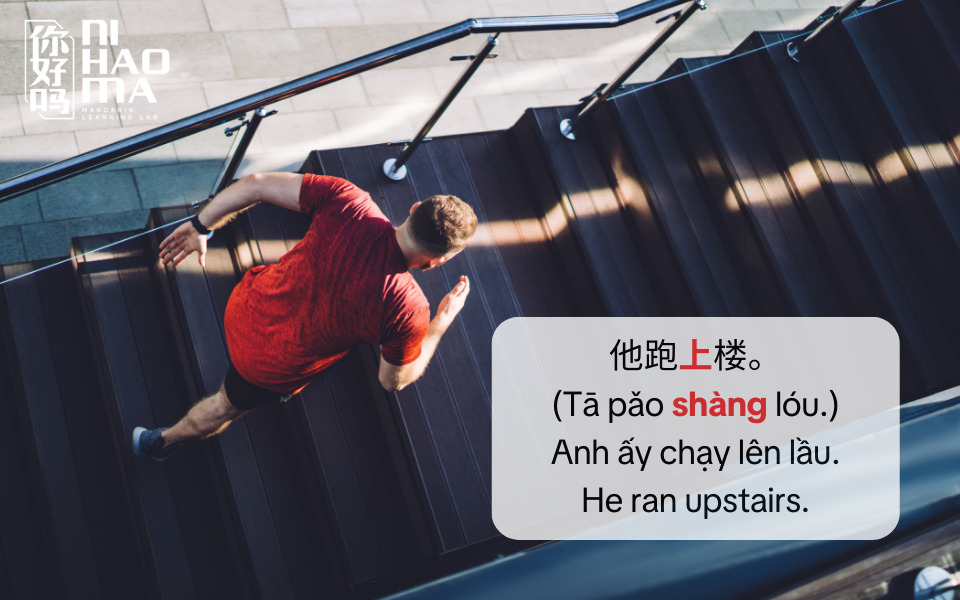
Compound Directional Complement (复合方向补语)
Compound directional complements are a type of Chinese complements used to describe the direction of movement in a more detailed manner. These complements not only indicate the basic direction of an action (such as up, down, in, out, etc.), but also add information about the relationship between the movement and the speaker or listener’s position.
In other words, compound directional complements describe both the physical direction of the action and whether the action moves toward or away from the speaker/listener.
Verb + Compound Directional Complement + (Object)
These complements are formed by combining two parts:
- Simple directional complement: 上 (shàng – up), 下 (xià – down), 进 (jìn – in), 出 (chū – out), 回 (huí – return), 过 (guò – cross/pass), 起 (qǐ – rise)
- Movement relative to the speaker/listener: 来 (lái – toward the speaker) / 去 (qù – away from the speaker)
Examples:
上来 (shànglái): to come up (toward the speaker)
Example: 快上来!(Kuài shànglái!) – Hurry up here!
上去 (shàngqù): to go up (away from the speaker)
Example: 他已经上去了。(Tā yǐjīng shàngqù le.) – He has already gone up.
下去 (xiàqù): to go down (away from the speaker)
Example: 他走下去了。(Tā zǒu xiàqù le.) – He walked down.
回来 (huílái): to come back (toward the speaker)
Example: 你什么时候回来?(Nǐ shénme shíhòu huílái?) – When will you come back?
6. Frequency Complements
Frequency complements, another important category of Chinese complements, are grammatical components placed after a verb to indicate how many times the action has been performed. These complements allow the speaker to express the frequency of an action, helping to convey how often something has occurred. In sentences containing frequency complements, aspect markers like 了 (le) or 过 (guò) are usually placed after the verb and before the frequency complement.
Position of Frequency Complements Depending on the Object:
| Case | Sentence Structure | Example |
|---|---|---|
| No object | Subject + Verb + Frequency Complement | 我去了两次。 (Wǒ qù le liǎng cì.) – I went there twice. |
| Object is a thing | Subject + Verb + Frequency Complement + Object | 我看了三遍这本书。 (Wǒ kàn le sān biàn zhè běn shū.) – I read this book three times. |
| Object is a person | Subject + Verb + Object + Frequency Complement | 我见过他两次。 (Wǒ jiàn guò tā liǎng cì.) – I’ve met him twice. |
| Object is a place | Subject + Verb + Object + Frequency Complement | 我去过北京三次。 (Wǒ qù guò Běijīng sān cì.) – I’ve been to Beijing three times. |
? Note: If an aspect particle like 过 (guò) or 了 (le) is present, the frequency complement usually comes after the aspect particle.
Example:
他来过这里两次。
(Tā lái guò zhèlǐ liǎng cì.)
He has been here twice.
See also: Objects in Chinese and Important Notes
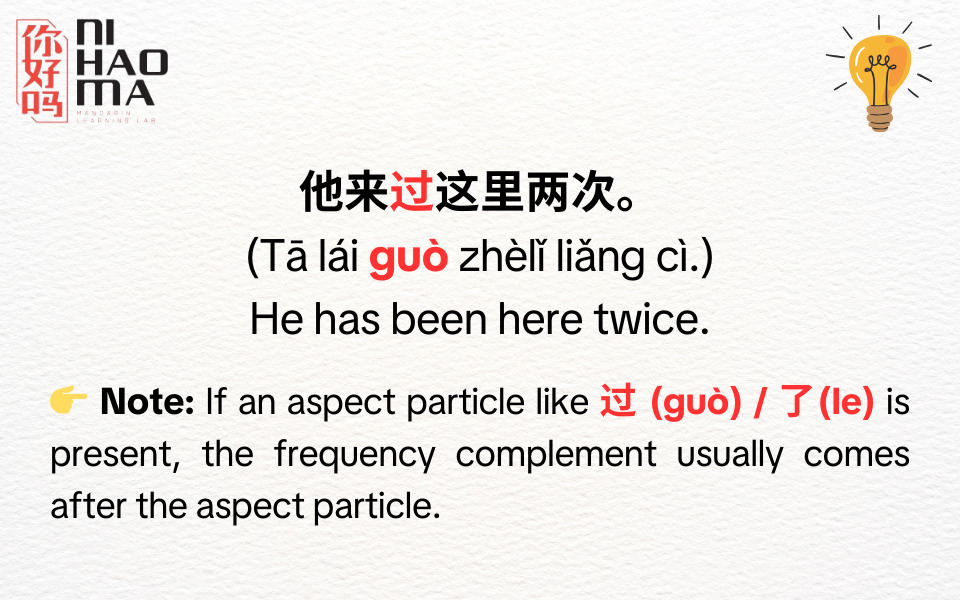
Important Notes When Using Chinese Complements
Mastering the use of Chinese complements requires learners to firmly grasp certain rules and key points. Without this understanding, sentences may become ambiguous, incorrect, or even misleading to listeners.
Using the Right Complement
You cannot arbitrarily substitute one type of complement for another in Chinese, as each type of complement conveys a distinct grammatical meaning. Incorrectly replacing a complement will result in inaccurate sentences, cause misunderstandings, or even completely change the intended meaning.
Example:
- 他走上楼了。(Tā zǒu shàng lóu le) – He has gone upstairs.
Here, “上” (shàng) functions as a directional complement, indicating the movement direction of the verb “走” (zǒu – to walk). If you replace “上” (shàng) with “完” (wán – to finish), the sentence becomes:
- 他走完了楼了。(Tā zǒu wán le lóu le) – He finished walking the building. (This is unnatural and grammatically incorrect.)
Using the Appropriate Aspect Particle
Aspect particles like “了” (le) and “过” (guò) are often used together with Chinese complements to express different action states.
- “了” (le) indicates that the action has been completed.
Example: 我看完了这本书。(Wǒ kàn wán le zhè běn shū.) – I have finished reading this book. - “过” (guò) indicates that the action has occurred at least once in the past.
Example: 我去过中国。(Wǒ qù guò Zhōngguó.) – I have been to China.
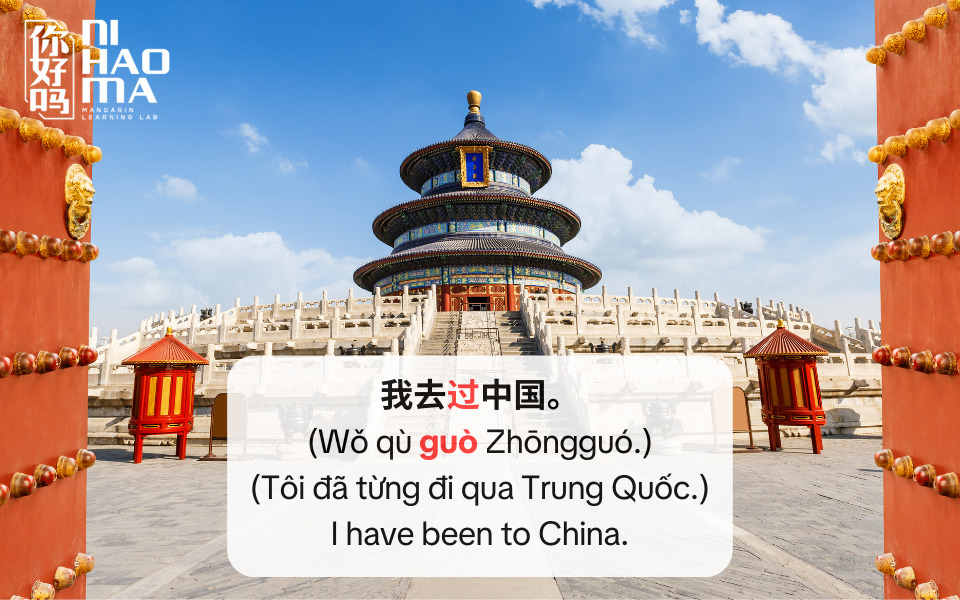
Not All Verbs Can Take Complements
Some verbs inherently carry a sense of result or degree, meaning they do not require or are incompatible with certain complements. On the other hand, some verbs must be followed by a complement to form a complete sentence.
Example:
- 吃完 (chī wán): To finish eating — a natural and correct combination.
- 死完 (sǐ wán): To finish dying — this is unnatural and incorrect because the verb “死” (to die) does not logically combine with the complement “完” (to finish).
Explore More: 100 Most Common Chinese Verbs
Distinguishing Complements from Adverbials and Objects
Chinese complements add additional information to the verb, but learners often confuse them with adverbials (which modify the entire sentence or verb) and objects (which receive the action). Mixing up these components leads to incorrect sentence structures.
Example:
- 他跑得很快。(Tā pǎo de hěn kuài.)
→ “很快” (hěn kuài – very fast) functions as a degree complement, modifying the verb “跑” (pǎo – to run). - 他很快地跑过来。(Tā hěn kuài de pǎo guòlái.)
→ “很快地” (hěn kuài de – quickly) functions as an adverbial, describing how the action “跑过来” (pǎo guòlái – to run over) is performed.
Summary
Chinese complements are an indispensable part of Chinese grammar, making sentences more complete, precise, and natural. Mastering the different types of Chinese complements will help learners avoid common mistakes and improve their ability to form grammatically correct sentences. Hopefully, through this article from Ni Hao Ma, you have gained a comprehensive understanding of Chinese complements and can apply this knowledge effectively to your studies and real-life conversations.
